Multicriteria Decision-Making for Sustainable Mining: Evaluating the Transition to Net-Zero-Carbon Energy Systems
Abstract
1. Introduction
2. Literature Review
2.1. Overview of Sustainable Mining and Net-Zero-Carbon Goals
2.2. Challenges in Sustainable Mining
2.3. Introduction to Multicriteria Decision-Making (MCDM)
2.4. Applications of Fuzzy MCDM in Sustainability and Energy Systems
2.5. Research Gaps and Objectives
3. Materials and Methods
3.1. Fuzzy Set Theory
3.2. Triangular Fuzzy Quantity (TFQ)
3.3. TFQs and Arithmetic Operations
3.4. Fuzzy Analytical Hierarchy Process (Fuzzy AHP)
3.5. Overview of Fuzzy VIseKritejumska Optimizacija I Kompromisno Resenje (Fuzzy VIKOR)
3.6. Overview of Fuzzy Complex Proportional Assessment (Fuzzy COPRAS)
3.7. Case Study Description
3.8. Data Collection
4. Results
4.1. Expert Opinions
4.2. Weight Determination and Decision Matrix Aggregation
4.3. Matrix Formation
4.4. MCDM Methods
4.5. Fuzzy TOPSIS
4.6. Fuzzy COPRAS
4.7. Fuzzy VIKOR
4.8. Geometric Inverse Distance Aggregation
- Inverse Distance Normalization.
- 2.
- Geometric mean integration.
- 3.
- Final score calculation:
5. Discussion
Sensitivity Analysis
6. Challenges and Limitations
7. Conclusions
Author Contributions
Funding
Institutional Review Board Statement
Informed Consent Statement
Data Availability Statement
Conflicts of Interest
Appendix A. Sample Questionnaire
| Alternative | C1 | C2 | C3 | C4 | C5 | C6 | C7 | C8 | C9 | C10 |
|---|---|---|---|---|---|---|---|---|---|---|
| A1: Solar-powered mining operations | ||||||||||
| A2: Hydrogen-powered mining equipment | ||||||||||
| A3: Electrification of the mining fleet | ||||||||||
| A4: Waste heat recovery systems | ||||||||||
| A5: Deployment of AI for operational efficiency | ||||||||||
| A6: Transition to circular economy models |
| Criteria | Importance Rating |
|---|---|
| Community Impact (C1) | |
| Workforce Safety (C2) | |
| Cost Efficiency (C3) | |
| Carbon Emissions (C4) | |
| Land Restoration (C5) | |
| Regulatory Compliance (C6) | |
| Energy Efficiency (C7) | |
| Technological Feasibility (C8) | |
| Revenue Potential (C9) | |
| Policy Incentives (C10) |
References
- Mateus, A.; Martins, L. Challenges and opportunities for a successful mining industry in the future. Bol. Geol. Min. 2019, 130, 99–121. [Google Scholar] [CrossRef]
- Ericsson, M.; Löf, O. Mining’s contribution to national economies between 1996 and 2016. Miner. Econ. 2019, 32, 223–250. [Google Scholar] [CrossRef]
- Chang, X.; Li, Y.-X. Lead distribution in urban street dust and the relationship with mining, gross domestic product GDP and transportation and health risk assessment. Environ. Pollut. 2020, 262, 114307. [Google Scholar] [CrossRef] [PubMed]
- Sovacool, B.K. The precarious political economy of cobalt: Balancing prosperity, poverty, and brutality in artisanal and industrial mining in the Democratic Republic of the Congo. Extr. Ind. Soc. 2019, 6, 915–939. [Google Scholar] [CrossRef]
- Shilongo, G.M. Evaluating the Implementation of Environmental, Social and Governance Factors in the Mining Sector: A Case Study of Namibia. Master’s Thesis, Stellenbosch University, Stellenbosch, South Africa, 2023. [Google Scholar]
- Garvin, T.; McGee, T.K.; Smoyer-Tomic, K.E.; Aubynn, E.A. Community-company relations in gold mining in Ghana. J. Environ. Manag. 2009, 90, 571–586. [Google Scholar] [CrossRef]
- Kepore, K.; Higgins, C.; Goddard, R. What do indigenous communities think of the CSR practices of mining companies? J. Law Gov. 2013, 8, 35–52. [Google Scholar] [CrossRef][Green Version]
- Kemp, D.; Worden, S.; Owen, J.R. Differentiated social risk: Rebound dynamics and sustainability performance in mining. Resour. Policy 2016, 50, 19–26. [Google Scholar] [CrossRef]
- Asr, E.T.; Kakaie, R.; Ataei, M.; Mohammadi, M.R.T. A review of studies on sustainable development in mining life cycle. J. Clean. Prod. 2019, 229, 213–231. [Google Scholar] [CrossRef]
- Jhariya, D.C.; Khan, R.; Thakur, G.S. Impact of mining activity on water resource: An overview study. In Proceedings of the Seminar on Recent Practices and Innovations in Mining Industry, Raipur, India, 19–20 February 2016; pp. 19–20. [Google Scholar]
- Gorman, M.R.; Dzombak, D.A. A review of sustainable mining and resource management: Transitioning from the life cycle of the mine to the life cycle of the mineral. Resour. Conserv. Recycl. 2018, 137, 281–291. [Google Scholar] [CrossRef]
- Laurence, D. Establishing a sustainable mining operation: An overview. J. Clean. Prod. 2011, 19, 278–284. [Google Scholar] [CrossRef]
- Aznar-Sánchez, J.A.; Velasco-Muñoz, J.F.; Belmonte-Ureña, L.J.; Manzano-Agugliaro, F. Innovation and technology for sustainable mining activity: A worldwide research assessment. J. Clean. Prod. 2019, 221, 38–54. [Google Scholar] [CrossRef]
- Betz, M.R.; Partridge, M.D.; Farren, M.; Lobao, L. Coal mining, economic development, and the natural resources curse. Energy Econ. 2015, 50, 105–116. [Google Scholar] [CrossRef]
- Jiskani, I.M.; Cai, Q.; Zhou, W.; Lu, X. Assessment of risks impeding sustainable mining in Pakistan using fuzzy synthetic evaluation. Resour. Policy 2020, 69, 101820. [Google Scholar] [CrossRef]
- Deveci, M.; Varouchakis, E.A.; Brito-Parada, P.R.; Mishra, A.R.; Rani, P.; Bolgkoranou, M.; Galetakis, M. Evaluation of risks impeding sustainable mining using Fermatean fuzzy score function based SWARA method. Appl. Soft Comput. 2023, 139, 110220. [Google Scholar] [CrossRef]
- Agboola, O.; Babatunde, D.E.; Fayomi, O.S.I.; Sadiku, E.R.; Popoola, P.; Moropeng, L.; Yahaya, A.; Mamudu, O.A. A review on the impact of mining operation: Monitoring, assessment and management. Results Eng. 2020, 8, 100181. [Google Scholar] [CrossRef]
- Onifade, M.; Zvarivadza, T.; Adebisi, J.A.; Said, K.O.; Dayo-Olupona, O.; Lawal, A.I.; Khandelwal, M. Advancing toward sustainability: The emergence of green mining technologies and practices. Green Smart Min. Eng. 2024, 1, 157–174. [Google Scholar] [CrossRef]
- Samson, A.O.; Babatunde, O.M.; Denwigwe, I.H. Powering a space environment research laboratory (SERL): Hybrid renewable energy system or diesel system? Energy Eng. 2019, 116, 41–64. [Google Scholar] [CrossRef]
- Issa, M.; Ilinca, A.; Rousse, D.R.; Boulon, L.; Groleau, P. Renewable energy and decarbonization in the Canadian mining industry: Opportunities and challenges. Energies 2023, 16, 6967. [Google Scholar] [CrossRef]
- Paraszczak, J.; Fytas, K.; Laflamme, M. Feasibility of using electric trucks in deep metal mines. In Mine Planning and Equipment Selection, Proceedings of the 22nd MPES Conference, Dresden, Germany, 14–19 October 2013; Springer: Cham, Switzerland, 2014; pp. 1265–1275. [Google Scholar]
- Paraszczak, J.; Svedlund, E.; Fytas, K.; Laflamme, M. Electrification of loaders and trucks—A step towards more sustainable underground mining. Renew. Energy Power Qual. J. 2014, 12, 81–86. [Google Scholar] [CrossRef]
- Jacobs, W.; Hodkiewicz, M.R.; Bräunl, T. A cost-benefit analysis of electric loaders to reduce diesel emissions in underground hard rock mines. IEEE Trans. Ind. Appl. 2014, 51, 2565–2573. [Google Scholar] [CrossRef]
- Emezirinwune, M.U. Design and Construction of an Automatic Voltage Regulator for a Synchronous Alternator. Sci. Bull. Electr. Eng. Fac. 2022, 22, 1–7. [Google Scholar] [CrossRef]
- Stern, N.; Valero, A. Innovation, growth and the transition to net-zero emissions. Res. Policy 2021, 50, 104293. [Google Scholar] [CrossRef] [PubMed]
- Jiang, Y.; Li, Z.; Yang, G.; Zhang, Y.; Zhang, X. Recent progress on smart mining in China: Unmanned electric locomotive. Adv. Mech. Eng. 2017, 9, 1687814017695045. [Google Scholar] [CrossRef]
- Maskuroh, N.; Widyanty, W.; Nurhidajat, R.; Wardhana, I.; Fahlevi, M. Green human resource management and green supply Chain Management on Sustainable performance of nickel mining companies in Indonesia. Uncertain. Supply Chain. Manag. 2023, 11, 203–212. [Google Scholar] [CrossRef]
- Tiwari, N.K.; Pal, V.C. A Comprehensive review of the utilization of solar energy in the copper mining process. In Proceedings of the 2022 IEEE Silchar Subsection Conference (SILCON), Silchar, India, 4–6 November 2022; pp. 1–6. [Google Scholar]
- Nasirov, S.; Agostini, C.A. Mining experts’ perspectives on the determinants of solar technologies adoption in the Chilean mining industry. Renew. Sustain. Energy Rev. 2018, 95, 194–202. [Google Scholar] [CrossRef]
- Guo, Q.; Xi, X.; Yang, S.; Cai, M. Technology strategies to achieve carbon peak and carbon neutrality for China’s metal mines. Int. J. Miner. Metall. Mater. 2022, 29, 626–634. [Google Scholar] [CrossRef]
- Jiskani, I.M.; Moreno-Cabezali, B.M.; Rehman, A.U.; Fernandez-Crehuet, J.M.; Uddin, S. Implications to secure mineral supply for clean energy technologies for developing countries: A fuzzy based risk analysis for mining projects. J. Clean. Prod. 2022, 358, 132055. [Google Scholar] [CrossRef]
- Jiskani, I.M.; Cai, Q.; Zhou, W.; Lu, X.; Shah, S.A.A. An integrated fuzzy decision support system for analyzing challenges and pathways to promote green and climate smart mining. Expert. Syst. Appl. 2022, 188, 116062. [Google Scholar] [CrossRef]
- Liu, W.; Xu, J.; Cao, L.; Li, F. Towards iron ore mining sustainability and low-carbon transformation: Policies and implications. Resour. Policy 2024, 90, 104780. [Google Scholar] [CrossRef]
- Sovacool, B.K.; Bazilian, M.D.; Kim, J.; Griffiths, S. Six bold steps towards net-zero industry. Energy Res. Soc. Sci. 2023, 99, 103067. [Google Scholar] [CrossRef]
- Emezirinwune, M.U.; Adejumobi, I.A.; Adebisi, O.I.; Akinboro, F.G. Synergizing Hybrid Renewable Energy Systems and Sustainable Agriculture for Rural Development in Nigeria. e-Prime Adv. Electr. Eng. Electron. Energy 2024, 7, 100492. [Google Scholar] [CrossRef]
- Meadowcroft, J.; Rosenbloom, D. Governing the net-zero transition: Strategy, policy, and politics. Proc. Natl. Acad. Sci. USA 2023, 120, e2207727120. [Google Scholar] [CrossRef] [PubMed]
- Apostu, S.A.; Panait, M.; Vasile, V. The energy transition in Europe—A solution for net zero carbon? Environ. Sci. Pollut. Res. 2022, 29, 71358–71379. [Google Scholar] [CrossRef]
- Li, L.; Han, Y.; Li, Q.; Chen, W. Multi-dimensional economy-durability optimization method for integrated energy and transportation system of net-zero energy buildings. IEEE Trans. Sustain. Energy 2023, 15, 146–159. [Google Scholar] [CrossRef]
- Oladapo, B.I.; Olawumi, M.A.; Olugbade, T.O.; Ismail, S.O. Data analytics driving net zero tracker for renewable energy. Renew. Sustain. Energy Rev. 2025, 208, 115061. [Google Scholar] [CrossRef]
- Rosenbloom, D.; Meadowcroft, J. Accelerating pathways to net zero: Governance strategies from transition studies and the transition accelerator. Curr. Clim. Change Rep. 2022, 8, 104–114. [Google Scholar] [CrossRef]
- Perlaviciute, G.; Steg, L.; Sovacool, B.K. A perspective on the human dimensions of a transition to net-zero energy systems. Energy Clim. Change 2021, 2, 100042. [Google Scholar] [CrossRef]
- Renné, D.S. Progress, opportunities and challenges of achieving net-zero emissions and 100% renewables. Sol. Compass 2022, 1, 100007. [Google Scholar] [CrossRef]
- De La Peña, L.; Guo, R.; Cao, X.; Ni, X.; Zhang, W. Accelerating the energy transition to achieve carbon neutrality. Resour. Conserv. Recycl. 2022, 177, 105957. [Google Scholar] [CrossRef]
- Emezirinwune, M.U.; Adejumobi, I.A.; Adebisi, O.I.; Akinboro, F.G. Off-grid PV/biomass/DG/battery hybrid renewable energy as a source of electricity for a farm facility. e-Prime Adv. Electr. Eng. Electron. Energy 2024, 10, 100808. [Google Scholar] [CrossRef]
- Sovacool, B.K.; Del Rio, D.F.; Zhang, W. The political economy of net-zero transitions: Policy drivers, barriers, and justice benefits to decarbonization in eight carbon-neutral countries. J. Environ. Manag. 2023, 347, 119154. [Google Scholar] [CrossRef] [PubMed]
- Adedoja, O.S.; Sadiku, E.R.; Hamam, Y. A techno-economic assessment of the viability of a photovoltaic-wind-battery storage-hydrogen energy system for electrifying primary healthcare centre in Sub-Saharan Africa. Energy Convers. Manag. X 2024, 23, 100643. [Google Scholar] [CrossRef]
- Pimentel, B.S.; Gonzalez, E.S.; Barbosa, G.N.O. Decision-support models for sustainable mining networks: Fundamentals and challenges. J. Clean. Prod. 2016, 112, 2145–2157. [Google Scholar] [CrossRef]
- Lechner, A.M.; McIntyre, N.; Witt, K.; Raymond, C.M.; Arnold, S.; Scott, M.; Rifkin, W. Challenges of integrated modelling in mining regions to address social, environmental and economic impacts. Environ. Model. Softw. 2017, 93, 268–281. [Google Scholar] [CrossRef]
- Hamilton, S.H.; ElSawah, S.; Guillaume, J.H.A.; Jakeman, A.J.; Pierce, S.A. Integrated assessment and modelling: Overview and synthesis of salient dimensions. Environ. Model. Softw. 2015, 64, 215–229. [Google Scholar] [CrossRef]
- Fasesin, K.; Oladinni, A.; Emezirinwune, M.U.; Oba-Sulaiman, Z.; Abdulsalam, K.A. Renewable Energy in Developing Countries: Challenges, Opportunities, and Policy Recommendations for Innovative Funding. Adeleke Univ. J. Sci. 2024, 3, 120–129. Available online: https://aujs.adelekeuniversity.edu.ng/index.php/aujs/article/view/162 (accessed on 28 December 2024).
- Sovacool, B.K.; Del Rio, D.F.; Herman, K.; Iskandarova, M.; Uratani, J.M.; Griffiths, S. Reconfiguring European industry for net-zero: A qualitative review of hydrogen and carbon capture utilization and storage benefits and implementation challenges. Energy Environ. Sci. 2024, 17, 3523–3569. [Google Scholar] [CrossRef]
- Ii, J.C.A.; Maier, H.R.; Ravalico, J.K.; Strudley, M.W. Future research challenges for incorporation of uncertainty in environmental and ecological decision-making. Ecol. Model. 2008, 219, 383–399. [Google Scholar]
- Gregory, R.; Keeney, R.L. A practical approach to address uncertainty in stakeholder deliberations. Risk Anal. 2017, 37, 487–501. [Google Scholar] [CrossRef]
- Soltani, A.; Hewage, K.; Reza, B.; Sadiq, R. Multiple stakeholders in multi-criteria decision-making in the context of municipal solid waste management: A review. Waste Manag. 2015, 35, 318–328. [Google Scholar] [CrossRef]
- Mosadeghi, R.; Warnken, J.; Tomlinson, R.; Mirfenderesk, H. Uncertainty analysis in the application of multi-criteria decision-making methods in Australian strategic environmental decisions. J. Environ. Plan. Manag. 2013, 56, 1097–1124. [Google Scholar] [CrossRef]
- Taherdoost, H.; Madanchian, M. Multi-criteria decision making (MCDM) methods and concepts. Encyclopedia 2023, 3, 77–87. [Google Scholar] [CrossRef]
- Bhole, G.P.; Deshmukh, T. Multi-criteria decision making (MCDM) methods and its applications. Int. J. Res. Appl. Sci. Eng. Technol. (IJRASET) 2018, 6, 899–915. [Google Scholar]
- Tadić, S.; Zečević, S.; Krstić, M. A novel hybrid MCDM model based on fuzzy DEMATEL, fuzzy ANP and fuzzy VIKOR for city logistics concept selection. Expert Syst. Appl. 2014, 41, 8112–8128. [Google Scholar] [CrossRef]
- Gavade, R.K. Multi-Criteria Decision Making: An overview of different selection problems and methods. Int. J. Comput. Sci. Inf. Technol. 2014, 5, 5643–5646. [Google Scholar]
- Babatunde, O.; Emezirinwune, M.; Adebisi, J.; Abdulsalam, K.A.; Akintayo, B.; Olanrewaju, O. A Fuzzy Multi-Criteria Approach for Selecting Sustainable Power Systems Simulation Software in Undergraduate Education. Sustainability 2024, 16, 8994. [Google Scholar] [CrossRef]
- Shahsavarani, A.M.; Azad Marz Abadi, E. The bases, principles, and methods of decision-making: A review of literature. Int. J. Med. Rev. 2015, 2, 214–225. [Google Scholar]
- Onuoha, H.; Denwigwe, I.; Babatunde, O.; Abdulsalam, K.A.; Adebisi, J.; Emezirinwune, M.; Okharedia, T.; Akindayomi, A.; Adisa, K.; Hamam, Y. Integrating GIS and AHP for Photovoltaic Farm Site Selection: A Case Study of Ikorodu, Nigeria. Processes 2025, 13, 164. [Google Scholar] [CrossRef]
- Hansen, P.; Devlin, N. Multi-criteria decision analysis (MCDA) in healthcare decision-making. Oxf. Res. Encycl. Econ. Financ. 2019. [Google Scholar] [CrossRef]
- Hajduk, S. Multi-criteria analysis in the decision-making approach for the linear ordering of urban transport based on TOPSIS technique. Energies 2021, 15, 274. [Google Scholar] [CrossRef]
- Mardani, A.; Jusoh, A.; Zavadskas, E.K. Fuzzy multiple criteria decision-making techniques and applications—Two decades review from 1994 to 2014. Expert Syst. Appl. 2015, 42, 4126–4148. [Google Scholar]
- Wang, C.-N.; Yang, F.-C.; Vo, T.M.N.; Nguyen, V.T.T.; Singh, M. Enhancing efficiency and cost-effectiveness: A groundbreaking bi-algorithm MCDM approach. Appl. Sci. 2023, 13, 9105. [Google Scholar] [CrossRef]
- de Kaa, G.; Rezaei, J.; Kamp, L.; de Winter, A. Photovoltaic technology selection: A fuzzy MCDM approach. Renew. Sustain. Energy Rev. 2014, 32, 662–670. [Google Scholar] [CrossRef]
- Igogo, T.; Awuah-Offei, K.; Newman, A.; Lowder, T.; Engel-Cox, J. Integrating renewable energy into mining operations: Opportunities, challenges, and enabling approaches. Appl. Energy 2021, 300, 117375. [Google Scholar] [CrossRef]
- Imasiku, K.; Thomas, V.M. The mining and technology industries as catalysts for sustainable energy development. Sustainability 2020, 12, 10410. [Google Scholar] [CrossRef]
- Bebbington, A.; Hinojosa, L.; Bebbington, D.H.; Burneo, M.L.; Warnaars, X. Contention and ambiguity: Mining and the possibilities of development. Dev. Change 2008, 39, 887–914. [Google Scholar] [CrossRef]
- Norgate, T.; Haque, N. Energy and greenhouse gas impacts of mining and mineral processing operations. J. Clean. Prod. 2010, 18, 266–274. [Google Scholar] [CrossRef]
- Ditsele, O.; Awuah-Offei, K. Effect of mine characteristics on life cycle impacts of US surface coal mining. Int. J. Life Cycle Assess. 2012, 17, 287–294. [Google Scholar] [CrossRef]
- Moreno-Leiva, S.; Haas, J.; Junne, T.; Valencia, F.; Godin, H.; Kracht, W.; Nowak, W.; Eltrop, L. Renewable energy in copper production: A review on systems design and methodological approaches. J. Clean. Prod. 2020, 246, 118978. [Google Scholar] [CrossRef]
- Furnaro, A. Neoliberal energy transitions: The renewable energy boom in the Chilean mining economy. Environ. Plan. E Nat. Space 2020, 3, 951–975. [Google Scholar] [CrossRef]
- Votteler, R.G.; Brent, A.C. A literature review on the potential of renewable electricity sources for mining operations in South Africa. J. Energy South. Afr. 2016, 27, 1–21. [Google Scholar] [CrossRef]
- Zharan, K.; Bongaerts, J.C. Survey on Integrating of Renewable Energy into the Mining Industry. J. Environ. Account. Manag. 2018, 6, 149–165. [Google Scholar] [CrossRef]
- Zharan, K.; Bongaerts, J.C. Decision-making on the integration of renewable energy in the mining industry: A case studies analysis, a cost analysis and a SWOT analysis. J. Sustain. Min. 2017, 16, 162–170. [Google Scholar] [CrossRef]
- Kabeyi, M.J.B.; Olanrewaju, O.A. Sustainable energy transition for renewable and low carbon grid electricity generation and supply. Front. Energy Res. 2022, 9, 1032. [Google Scholar] [CrossRef]
- Sari, F. Comparison of TOPSIS and VIKOR multi criteria decision analysis techniques. Selçuk Üniv. Mühendis. Bilim Teknol. Derg. 2018, 6, 825–831. [Google Scholar] [CrossRef]
- Babatunde, M.O.; Ighravwe, D.E.; Oluseyi, P.; Mashao, D. Selection of an electricity tariff plan for mini-grid business models: An intuitionistic fuzzy axiomatic design approach. Technol. Econ. Smart Grids Sustain. Energy 2020, 5, 4. [Google Scholar] [CrossRef]
- Ighravwe, D.E.; Babatunde, M.O. Determination of a Suitable Renewable Energy Source for Mini-Grid Business: A Risk-Based Multicriteria Approach. J. Renew. Energy 2018, 2018, 2163262. [Google Scholar] [CrossRef]
- Ojo, Y.; Makinde, O.A.; Babatunde, O.V.; Babatunde, G.; Okeowo, S. Evaluating AI-Driven Mental Health Solutions: A Hybrid Fuzzy Multi-Criteria Decision-Making Approach. AI 2025, 6, 14. [Google Scholar] [CrossRef]
- Jato-Espino, D.; Castillo-Lopez, E.; Rodriguez-Hernandez, J.; Canteras-Jordana, J.C. A review of application of multi-criteria decision making methods in construction. Autom. Constr. 2014, 45, 151–162. [Google Scholar] [CrossRef]
- Hwang, C.-L.; Masud, A.S.M. Multiple Objective Decision Making—Methods and Applications: A State-of-the-Art Survey; Springer Science & Business Media: Berlin/Heidelberg, Germany; New York, NY, USA, 2012; Volume 164. [Google Scholar]
- Behzadian, M.; Otaghsara, S.K.; Yazdani, M.; Ignatius, J. A state-of the-art survey of TOPSIS applications. Expert Syst. Appl. 2012, 39, 13051–13069. [Google Scholar] [CrossRef]
- Kumar, R.; Khan, A.I.; Abushark, Y.B.; Alam, M.M.; Agrawal, A.; Khan, R.A. A knowledge-based integrated system of hesitant fuzzy set, AHP and TOPSIS for evaluating security-durability of web applications. IEEE Access 2020, 8, 48870–48885. [Google Scholar] [CrossRef]
- Sałabun, W. The mean error estimation of TOPSIS method using a fuzzy reference models. J. Theor. Appl. Comput. Sci. 2013, 7, 40–50. [Google Scholar]
- Wu, T.; Liu, X.; Liu, F. An interval type-2 fuzzy TOPSIS model for large scale group decision making problems with social network information. Inf. Sci. 2018, 432, 392–410. [Google Scholar] [CrossRef]
- Onu, P.U.; Quan, X.; Xu, L.; Orji, J.; Onu, E. Evaluation of sustainable acid rain control options utilizing a fuzzy TOPSIS multi-criteria decision analysis model frame work. J. Clean. Prod. 2017, 141, 612–625. [Google Scholar] [CrossRef]
- Hatami-Marbini, A.; Kangi, F. An extension of fuzzy TOPSIS for a group decision making with an application to Tehran stock exchange. Appl. Soft Comput. 2017, 52, 1084–1097. [Google Scholar] [CrossRef]
- Samanlioglu, F.; Taskaya, Y.E.; Gulen, U.C.; Cokcan, O. A fuzzy AHP--TOPSIS-based group decision-making approach to IT personnel selection. Int. J. Fuzzy Syst. 2018, 20, 1576–1591. [Google Scholar] [CrossRef]
- He, Y.-H.; Wang, L.-B.; He, Z.-Z.; Xie, M. A fuzzy TOPSIS and rough set based approach for mechanism analysis of product infant failure. Eng. Appl. Artif. Intell. 2016, 47, 25–37. [Google Scholar] [CrossRef]
- Sengül, Ü.; Eren, M.; Shiraz, S.E.; Gezder, V.; Sengül, A.B. Fuzzy TOPSIS method for ranking renewable energy supply systems in Turkey. Renew. Energy 2015, 75, 617–625. [Google Scholar] [CrossRef]
- Chen, T.-Y. The inclusion-based TOPSIS method with interval-valued intuitionistic fuzzy sets for multiple criteria group decision making. Appl. Soft Comput. 2015, 26, 57–73. [Google Scholar] [CrossRef]
- Kannan, D.; de Sousa Jabbour, A.B.L.; Jabbour, C.J.C. Selecting green suppliers based on GSCM practices: Using fuzzy TOPSIS applied to a Brazilian electronics company. Eur. J. Oper. Res. 2014, 233, 432–447. [Google Scholar] [CrossRef]
- Taylan, O.; Bafail, A.O.; Abdulaal, R.M.S.; Kabli, M.R. Construction projects selection and risk assessment by fuzzy AHP and fuzzy TOPSIS methodologies. Appl. Soft Comput. 2014, 17, 105–116. [Google Scholar] [CrossRef]
- Gul, M.; Celik, E.; Aydin, N.; Gumus, A.T.; Guneri, A.F. A state of the art literature review of VIKOR and its fuzzy extensions on applications. Appl. Soft Comput. 2016, 46, 60–89. [Google Scholar] [CrossRef]
- Mardani, A.; Zavadskas, E.K.; Govindan, K.; Senin, A.A.; Jusoh, A. VIKOR technique: A systematic review of the state of the art literature on methodologies and applications. Sustainability 2016, 8, 37. [Google Scholar] [CrossRef]
- Opricovic, S. Fuzzy VIKOR with an application to water resources planning. Expert Syst. Appl. 2011, 38, 12983–12990. [Google Scholar] [CrossRef]
- Zhang, N.; Wei, G. Extension of VIKOR method for decision making problem based on hesitant fuzzy set. Appl. Math. Model. 2013, 37, 4938–4947. [Google Scholar] [CrossRef]
- Omerali, M.; Kaya, T. Augmented reality application selection framework using spherical fuzzy COPRAS multi criteria decision making. Cogent Eng. 2022, 9, 2020610. [Google Scholar] [CrossRef]
- Ghose, D.; Pradhan, S.; Tamuli, P.; Shabbiruddin. Optimal material for solar electric vehicle application using an integrated Fuzzy-COPRAS model. Energy Sources Part A Recovery Util. Environ. Eff. 2023, 45, 3859–3878. [Google Scholar] [CrossRef]
- Ighravwe, D.E.; Babatunde, M.O.; Mosetlhe, T.C.; Aikhuele, D.; Akinyele, D. A MCDM-based framework for the selection of renewable energy system simulation tool for teaching and learning at university level. Environ. Dev. Sustain. 2021, 24, 13035–13056. [Google Scholar] [CrossRef]
- Chatterjee, N.C.; Bose, G.K. A COPRAS-F base multi-criteria group decision making approach for site selection of wind farm. Decis. Sci. Lett. 2012, 2, 1–10. [Google Scholar] [CrossRef]
- Ighravwe, D.E.; Oke, S.A. An integrated approach of SWARA and fuzzy COPRAS for maintenance technicians’ selection factors ranking. Int. J. Syst. Assur. Eng. Manag. 2019, 10, 1615–1626. [Google Scholar] [CrossRef]
- Zavadskas, E.K.; Kaklauskas, A.; Turskis, Z.; Tamošaitiene, J. Selection of the effective dwelling house walls by applying attributes values determined at intervals. J. Civ. Eng. Manag. 2008, 14, 85–93. [Google Scholar] [CrossRef]
- Zavadskas, E.K.; Kaklauskas, A.; Šarka, V. The New Method of Multicriteria Complex Proportional Assessment of Projects; Technika: Vilnius, Lithuania, 1994. [Google Scholar]
- Garg, R.; Kumar, R.; Garg, S. MADM-based parametric selection and ranking of E-learning websites using fuzzy COPRAS. IEEE Trans. Educ. 2018, 62, 11–18. [Google Scholar] [CrossRef]
- Hunt, J.D.; Nascimento, A.; Nascimento, N.; Vieira, L.W.; Romero, O.J. Possible pathways for oil and gas companies in a sustainable future: From the perspective of a hydrogen economy. Renew. Sustain. Energy Rev. 2022, 160, 112291. [Google Scholar] [CrossRef]
- Barbosa, F.C. Fuel cell rail technology review: A tool for an autonomous rail electrifying strategy. In Proceedings of the ASME/IEEE Joint Rail Conference, Snowbird, UT, USA, 9–12 April 2019; p. V001T07A001. [Google Scholar]
- Selvarajan, G.P. Harnessing AI-Driven Data Mining for Predictive Insights: A Framework for Enhancing Decision-Making in Dynamic Data Environments. Int. J. Creat. Res. Thoughts 2021, 9, 5476–5486. [Google Scholar]
- Mancini, L.; Sala, S. Social impact assessment in the mining sector: Review and comparison of indicators frameworks. Resour. Policy 2018, 57, 98–111. [Google Scholar] [CrossRef]
- Asiedu, E.A.; Appiagyei, J.N.; Amfo-Otu, R.; Parku, K.; Obuobisa-Darko, T. Occupational health and safety, cost reduction in accident and employee task performance: Perspectives of selected service organizations. J. Public Health 2023, 1–12. [Google Scholar] [CrossRef]
- Kern, C.; Jess, A. Reducing global greenhouse gas emissions to meet climate targets—A comprehensive quantification and reasonable options. Energies 2021, 14, 5260. [Google Scholar] [CrossRef]
- Rosa, J.C.S.; Morrison-Saunders, A.; Hughes, M.; Sánchez, L.E. Planning mine restoration through ecosystem services to enhance community engagement and deliver social benefits. Restor. Ecol. 2020, 28, 937–946. [Google Scholar] [CrossRef]
- O’Faircheallaigh, C. Social equity and large mining projects: Voluntary industry initiatives, public regulation and community development agreements. J. Bus. Ethics 2015, 132, 91–103. [Google Scholar] [CrossRef]
- Espinoza, R.D.; Rojo, J. Towards sustainable mining (Part I): Valuing investment opportunities in the mining sector. Resour. Policy 2017, 52, 7–18. [Google Scholar] [CrossRef]
- Osei, V.; Bai, C.; Asante-Darko, D.; Quayson, M. Evaluating the barriers and drivers of adopting circular economy for improving sustainability in the mining industry. Resour. Policy 2023, 86, 104168. [Google Scholar] [CrossRef]
- Yu, H.; Zahidi, I.; Fai, C.M.; Liang, D.; Madsen, D.Ø. Elevating community well-being in mining areas: The proposal of the mining area sustainability index (MASI). Environ. Sci. Eur. 2024, 36, 71. [Google Scholar] [CrossRef]

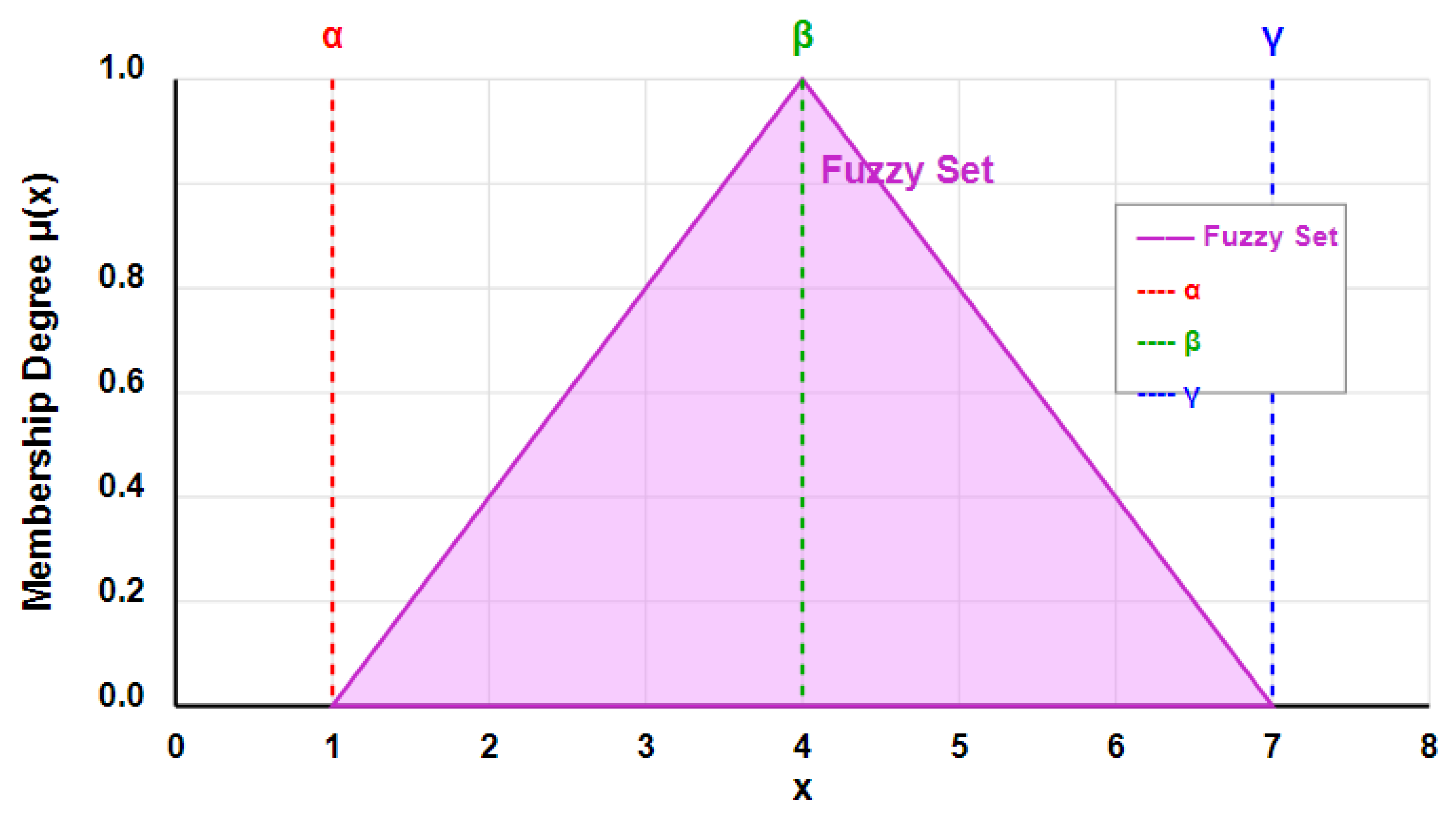
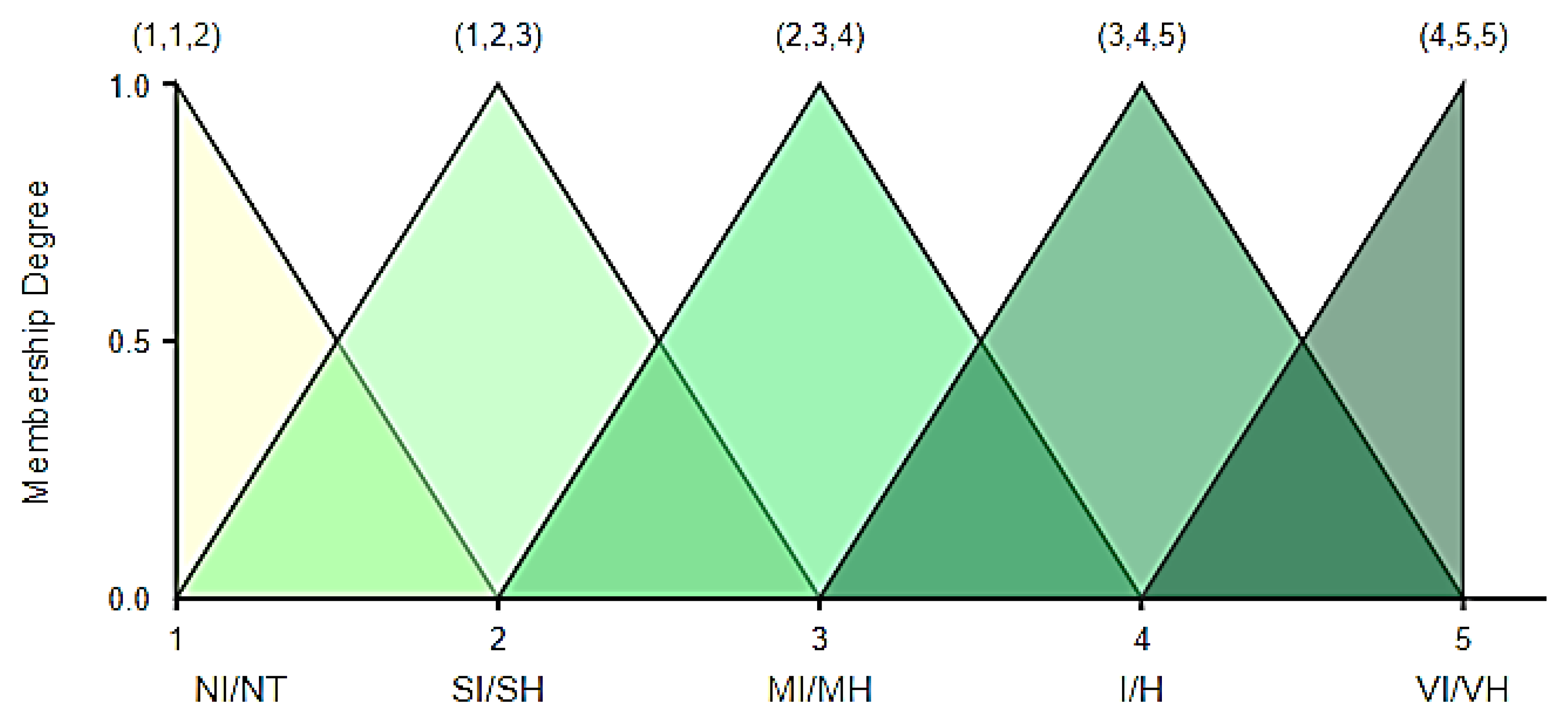
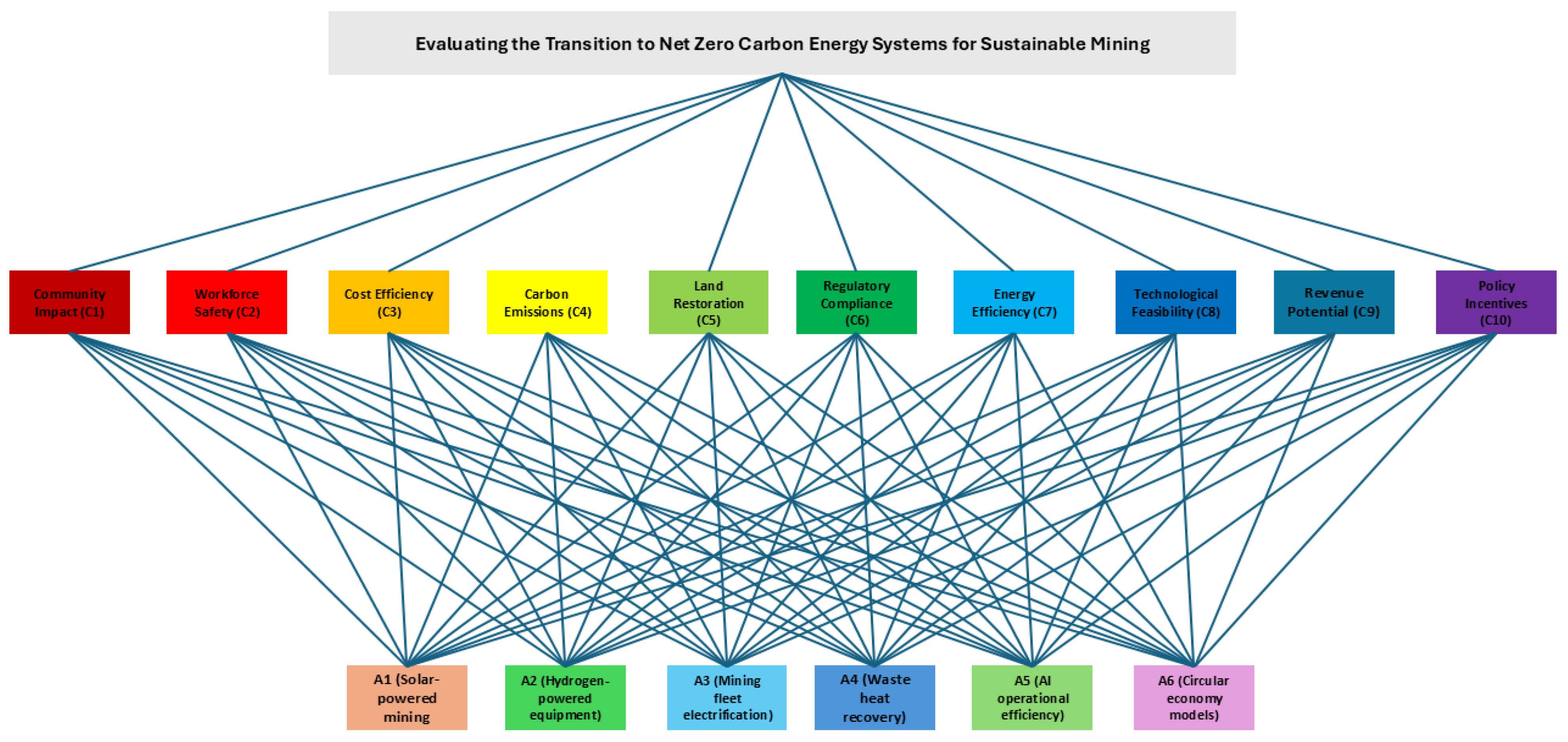
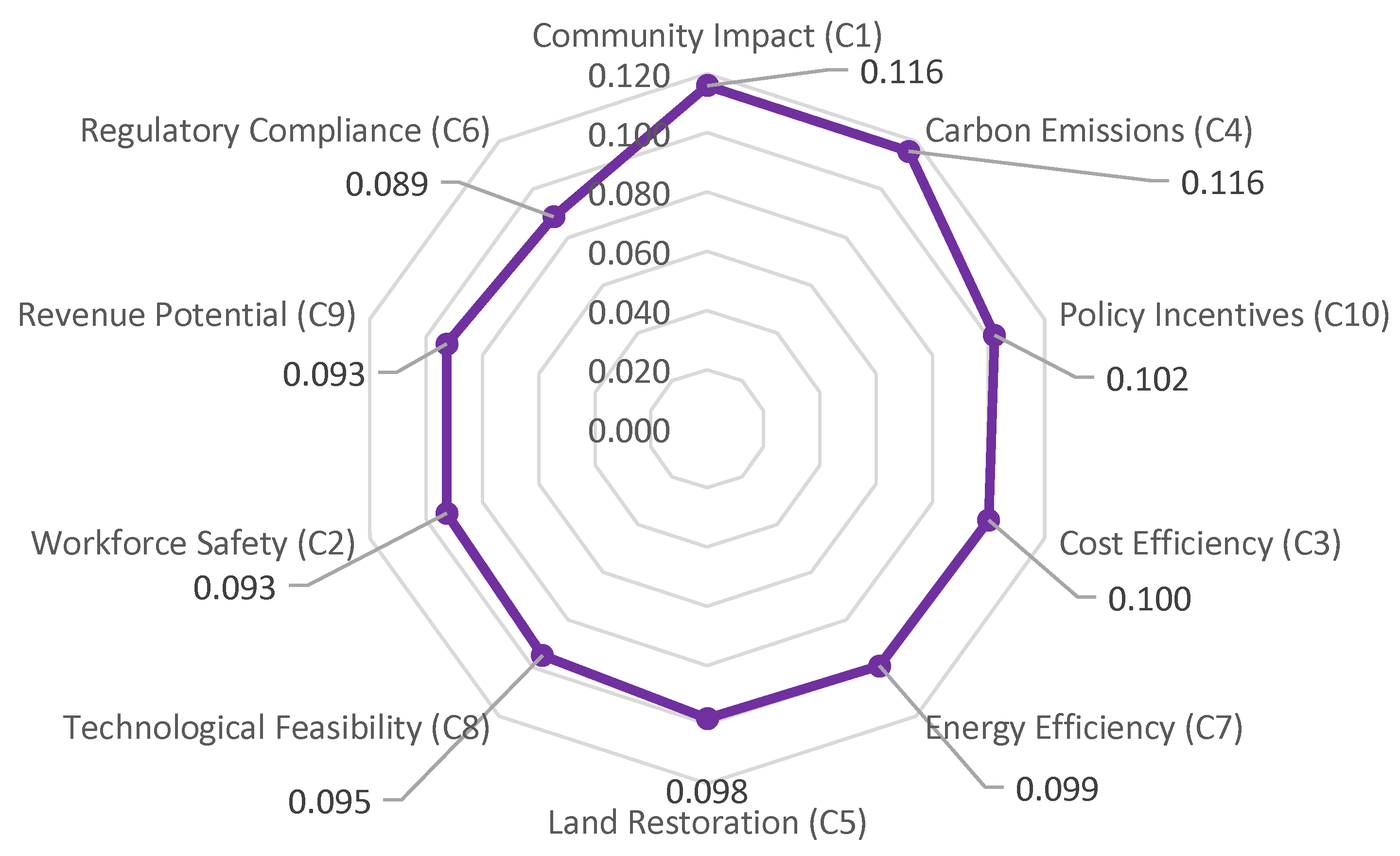
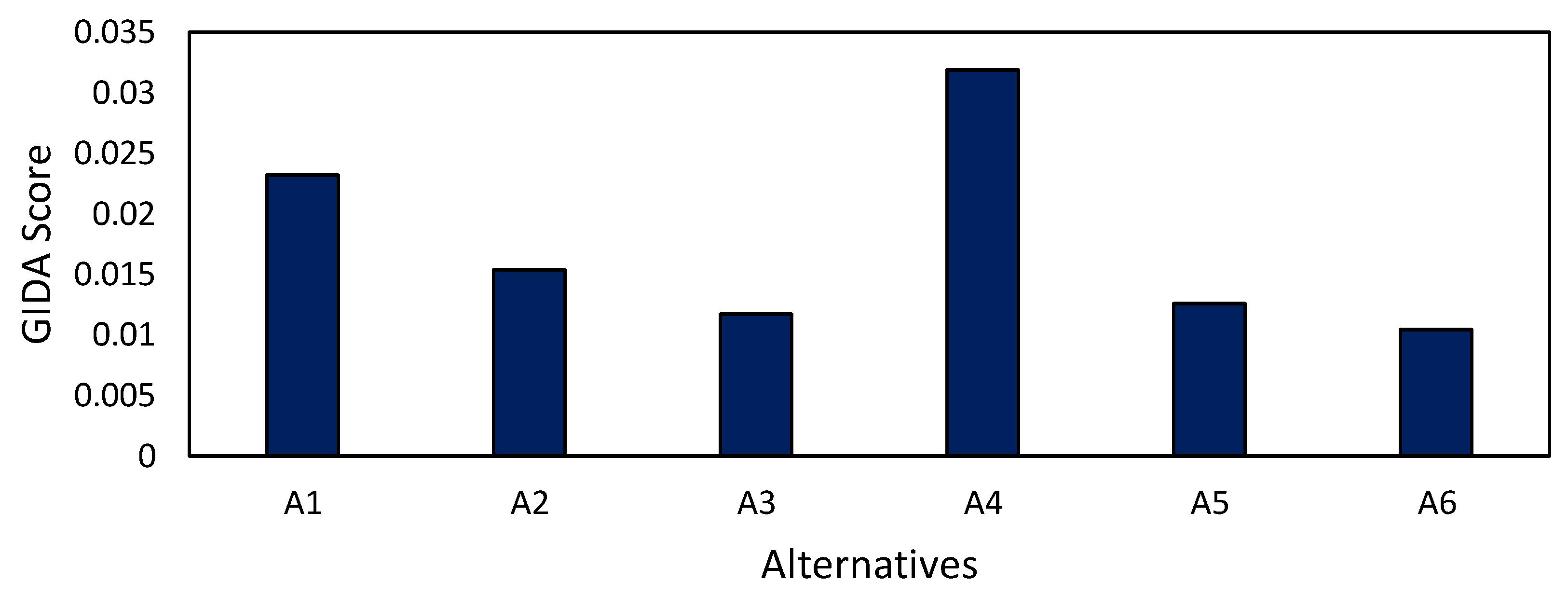

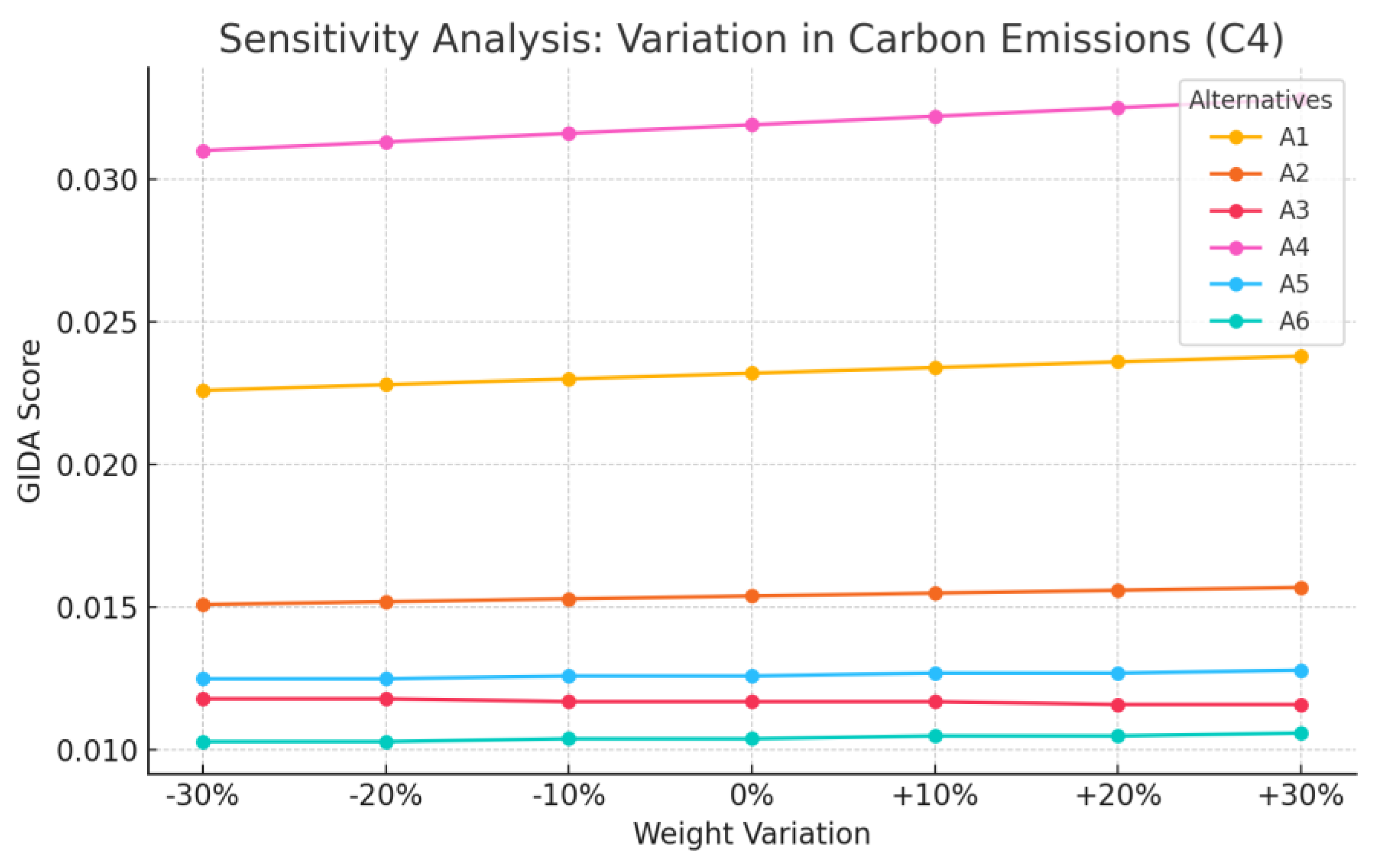
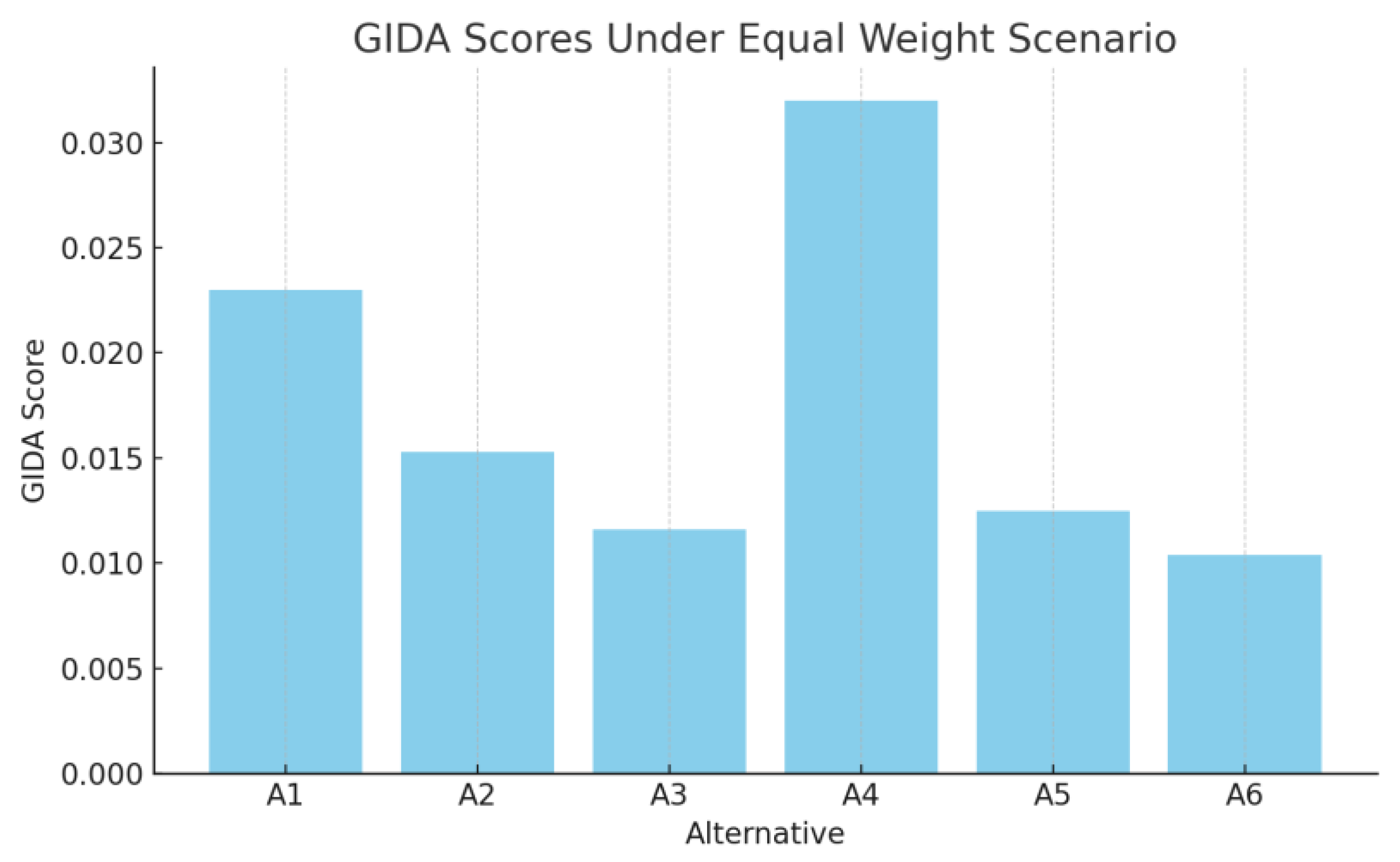
| Alternative | ||
|---|---|---|
| Alternative | Code | Description |
| Solar-powered mining operations | A1 | Using solar energy to power mining equipment and processes reduces reliance on fossil fuels [50]. This alternative is exceptionally viable in regions with high solar irradiance and limited grid access [19]. |
| Hydrogen-powered mining equipment | A2 | Deploying hydrogen fuel cell technology to operate mining machinery with zero emissions [109]. It offers a long-term clean energy solution but requires significant infrastructure investment. |
| Electrification of the mining fleet | A3 | Replacing diesel-powered vehicles and equipment with electric-powered alternatives. This transition can reduce fuel costs and emissions but may be constrained by battery performance in heavy-duty applications [110]. |
| Waste heat recovery systems | A4 | Capturing and reusing waste heat from mining operations to improve energy efficiency. It is a technically mature solution that can be integrated into existing thermal processes with modest investment [68]. |
| Deployment of AI for operational efficiency | A5 | Leveraging AI tools to optimize mining processes, minimize waste, and improve decision-making. AI enhances predictive maintenance and productivity but requires skilled personnel and digital infrastructure [111]. |
| Transition to circular economy models | A6 | Adopting recycling, reuse, and waste minimization strategies to create sustainable mining ecosystems [50]. This approach supports long-term sustainability but may need policy alignment and stakeholder engagement. |
| Criteria | ||
| Criterion | Code | Description |
| Community Impact | C1 | Mining operations’ positive or negative effects on local communities, including job creation and social benefits. This criterion captures the social sustainability of mining practices and their acceptance by host communities [112]. |
| Workforce Safety | C2 | Measures taken to protect workers from accidents, injuries, and occupational health risks. Ensuring safety improves worker morale and reduces costs related to health and insurance [113]. |
| Cost Efficiency | C3 | The balance between operational costs and benefits gained from the mining practice [19]. It reflects the economic feasibility of implementing the alternative. |
| Carbon Emissions | C4 | The extent to which the alternative reduces greenhouse gas emissions. This is a key metric in meeting global climate goals and regulatory targets [114]. |
| Land Restoration | C5 | Efforts to rehabilitate and restore mining sites after operations. Effective restoration enhances environmental recovery and community trust [115]. |
| Regulatory Compliance | C6 | Adherence to environmental regulations and industry standards. Failure to comply can result in fines, project delays, or license revocation [116]. |
| Energy Efficiency | C7 | The effectiveness of the alternative in minimizing energy consumption while maintaining productivity. Higher efficiency translates to operational cost savings and reduced environmental impact [46]. |
| Technological Feasibility | C8 | The practicality of implementing the alternative within current technological constraints. This determines how readily the alternative can be adopted with existing tools and systems [46]. |
| Revenue Potential | C9 | The sustainable mining alternative generates long-term financial benefits. High revenue potential increases investor interest and project scalability [117]. |
| Policy Incentives | C10 | Support or incentives provided by governments or institutions to promote the alternative. This can significantly reduce implementation costs and accelerate adoption [118]. |
| Criteria | Expert 1 | Expert 2 | Expert 3 | Expert 4 | Expert 5 | Expert 6 | Expert 7 | Expert 8 |
|---|---|---|---|---|---|---|---|---|
| Community Impact (C1) | VI | VI | I | VI | VI | VI | VI | VI |
| Workforce Safety (C2) | VI | VI | VI | SI | VI | SI | SI | VI |
| Cost Efficiency (C3) | VI | VI | I | VI | MI | VI | VI | NI |
| Carbon Emissions (C4) | VI | VI | VI | VI | I | VI | VI | VI |
| Land Restoration (C5) | VI | I | MI | MI | VI | MI | I | VI |
| Regulatory Compliance (C6) | I | I | MI | MI | MI | MI | I | I |
| Energy Efficiency (C7) | VI | VI | I | I | I | I | I | SI |
| Technological Feasibility (C8) | I | MI | VI | VI | MI | VI | I | SI |
| Revenue Potential (C9) | VI | MI | I | I | SI | I | VI | MI |
| Policy Incentives (C10) | I | MI | VI | VI | SI | VI | VI | VI |
| Criterion | (l, m, u) | De-Fuzzified Value | Normalized Weight | Rank |
|---|---|---|---|---|
| C1 | (3.875, 4.875, 5.000) | 4.583 | 0.1159 | 1 |
| C2 | (2.875, 3.875, 4.250) | 4.583 | 0.1159 | 1 |
| C3 | (3.250, 4.125, 4.500) | 4.042 | 0.1022 | 3 |
| C4 | (3.875, 4.875, 5.000) | 3.958 | 0.1001 | 4 |
| C5 | (3.000, 4.000, 4.625) | 3.917 | 0.0991 | 5 |
| C6 | (2.500, 3.500, 4.500) | 3.875 | 0.098 | 6 |
| C7 | (3.000, 4.000, 4.750) | 3.75 | 0.0948 | 7 |
| C8 | (2.875, 3.875, 4.500) | 3.667 | 0.0927 | 8 |
| C9 | (2.750, 3.750, 4.500) | 3.667 | 0.0927 | 8 |
| C10 | (3.250, 4.250, 4.625) | 3.5 | 0.0885 | 10 |
| Alternative | F-TOPSIS (Closeness Coefficient) | Rank | F-VIKOR (Q Value) | Rank | F-COPRAS (Utility Degree) | Rank |
|---|---|---|---|---|---|---|
| A1 (solar-powered mining) | 0.08498 | 1 | 0.2452 | 3 | 98.94 | 2 |
| A2 (hydrogen-powered equipment) | 0.08331 | 5 | 0.4772 | 5 | 97.84 | 3 |
| A3 (mining fleet electrification) | 0.08396 | 4 | 0.6018 | 4 | 98.44 | 5 |
| A4 (waste heat recovery) | 0.08496 | 2 | 0.0000 | 1 | 100 | 1 |
| A5 (AI operational efficiency) | 0.08447 | 3 | 0.5707 | 2 | 99.48 | 4 |
| A6 (circular economy models) | 0.08179 | 6 | 0.6379 | 6 | 95.9 | 6 |
Disclaimer/Publisher’s Note: The statements, opinions and data contained in all publications are solely those of the individual author(s) and contributor(s) and not of MDPI and/or the editor(s). MDPI and/or the editor(s) disclaim responsibility for any injury to people or property resulting from any ideas, methods, instructions or products referred to in the content. |
© 2025 by the authors. Licensee MDPI, Basel, Switzerland. This article is an open access article distributed under the terms and conditions of the Creative Commons Attribution (CC BY) license (https://creativecommons.org/licenses/by/4.0/).
Share and Cite
Adedoja, O.S.; Sadiku, E.R.; Hamam, Y. Multicriteria Decision-Making for Sustainable Mining: Evaluating the Transition to Net-Zero-Carbon Energy Systems. Sustainability 2025, 17, 4566. https://doi.org/10.3390/su17104566
Adedoja OS, Sadiku ER, Hamam Y. Multicriteria Decision-Making for Sustainable Mining: Evaluating the Transition to Net-Zero-Carbon Energy Systems. Sustainability. 2025; 17(10):4566. https://doi.org/10.3390/su17104566
Chicago/Turabian StyleAdedoja, Oluwaseye Samson, Emmanuel Rotimi Sadiku, and Yskandar Hamam. 2025. "Multicriteria Decision-Making for Sustainable Mining: Evaluating the Transition to Net-Zero-Carbon Energy Systems" Sustainability 17, no. 10: 4566. https://doi.org/10.3390/su17104566
APA StyleAdedoja, O. S., Sadiku, E. R., & Hamam, Y. (2025). Multicriteria Decision-Making for Sustainable Mining: Evaluating the Transition to Net-Zero-Carbon Energy Systems. Sustainability, 17(10), 4566. https://doi.org/10.3390/su17104566







